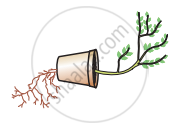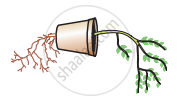Advertisements
Advertisements
प्रश्न
List two differences between the movement of leaves of a sensitive plant and the movement of a shoot towards light.
उत्तर
| Movement of leaves of a sensitive plant | Movement of a shoot towards light |
| A nastic movement is the name for the kind of movement that sensitive plant leaves exhibit. They occur instantly in reaction to a touch stimulation (thigmotropism). | Tropic movement describes a shoot's movement in the direction of light. A lengthier amount of time passes during it. |
| The direction of the stimulus has no bearing on this kind of movement. | Phototropism is the name for this movement, which is dependent on the direction of the light. Movement of this kind is growth-oriented and directional. |
संबंधित प्रश्न
Name the five types of tropisms.
One of the following plant hormones is responsible for the phenomenon of phototropism in plants. This is :
(a) gibberellin
(b) eltroxin
(c) cytokinin
(d) auxin
A growing seedling is kept in a dark room. A burning candle is placed near it for a few days. The top part of seedling bends towards the burning candle. This is an example of :
(a) chemotropism
(b) hydrotropism
(c) phototropism
(d) geotropism
Which of the following are not tropisms?
(i) growing of pollen tube in response to a sugary substance
(ii) folding up of leaves of sensitive plant in response to touch
(iii) winding of tendril around a support in response to touch
(iv) opening up of the leaves of a daisy flower in response to light
(a) (i) and (ii) (b) (ii) and (iii) (c) (i) and (iv) (d) (ii) and (iv)
The chemical substance P is made and secreted by the meristematic tissue at the tip of stem (or shoot) of a plant. The chemical substance P is responsible for a phenomenon Q in plants in which the stem bends towards a source of light. The same chemical substance P has an opposite effect on the root of a plant. It causes the root of a plant to bend away from the source of light in a process called R.
(a) What is the chemical substance P?
(b) State whether P prefers to remains in the sunlit side of a stem or in shade.
(c) What is the effect of substance P on the rate of growth of (i) a root, and (ii) a stem?
(d) What is the name of process (i) Q, and (ii) R?
(e) What is the general name of chemical substances like P? Name another substance which belongs to this class of chemical substances.
While conducting experiments to study the effect of various stimuli on the plants, it was observed that the roots of a plant X grow and bend towards two stimuli A and B but bend away from a third stimulus C. The stem of the plant X, however, bends away from stimuli A and B but bends towards the stimulus C. The stimulus B is known to act on the roots due to too much weight of the earth. Keeping these points in mind, answer the following question:
- What could stimulus A be?
- Name the stimulus B.
- What could stimulus C be?
- The branches of a fallen tree in a forest grow straight up in response to two stimuli. What could be these two stimuli out of A, B and C? Also name these two stimuli.
The shoot system grows upward in response to ______.
In the given figure (a), (b) and (c), which appears more accurate and why?
 |
 |
 |
| (a) | (b) | (c) |
When the leaves of the Mimosa pudica plant are touched with a finger, they fold up quickly.
Give an example of negative hydrotropism.
